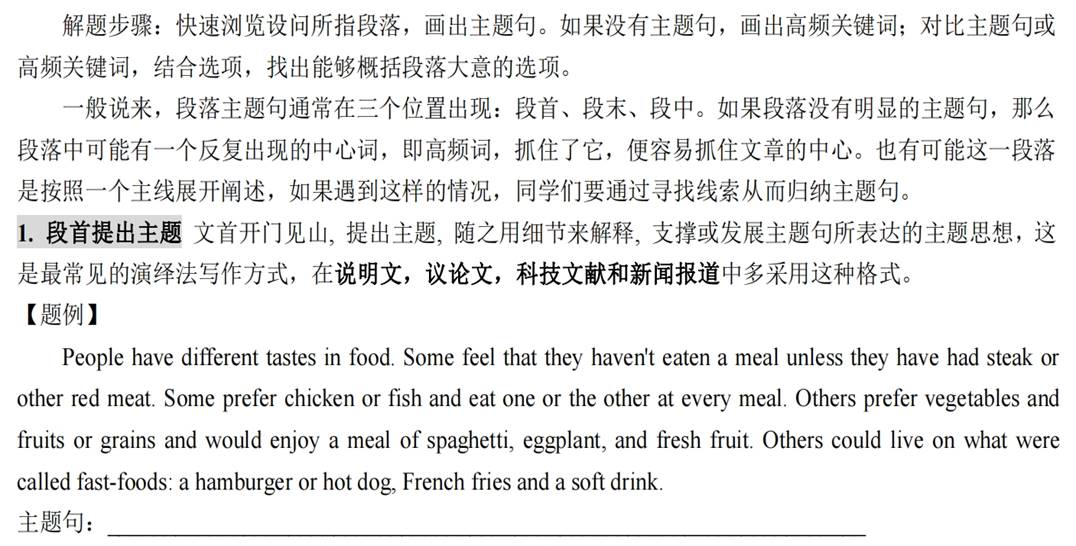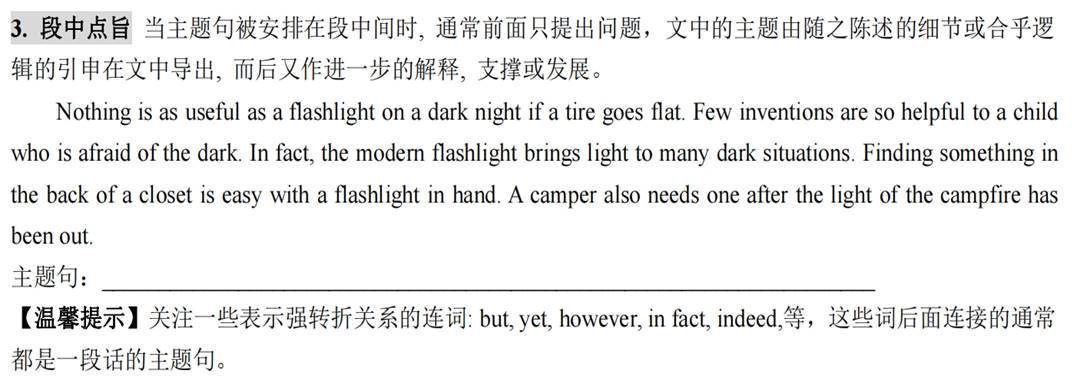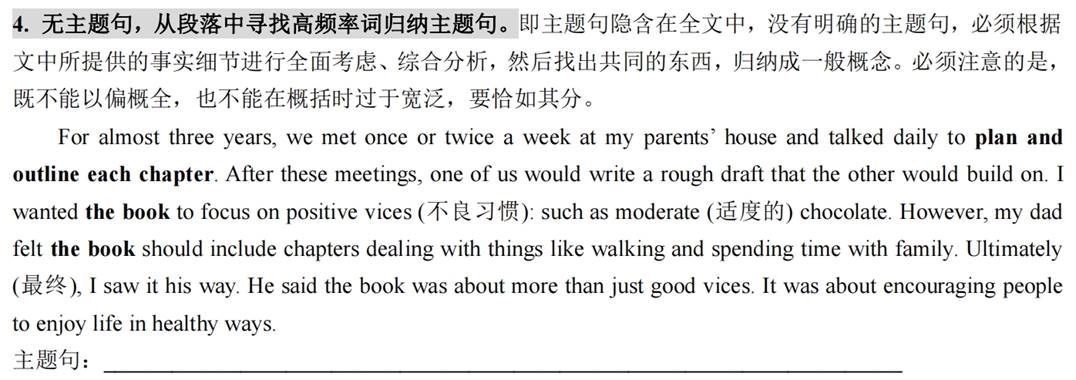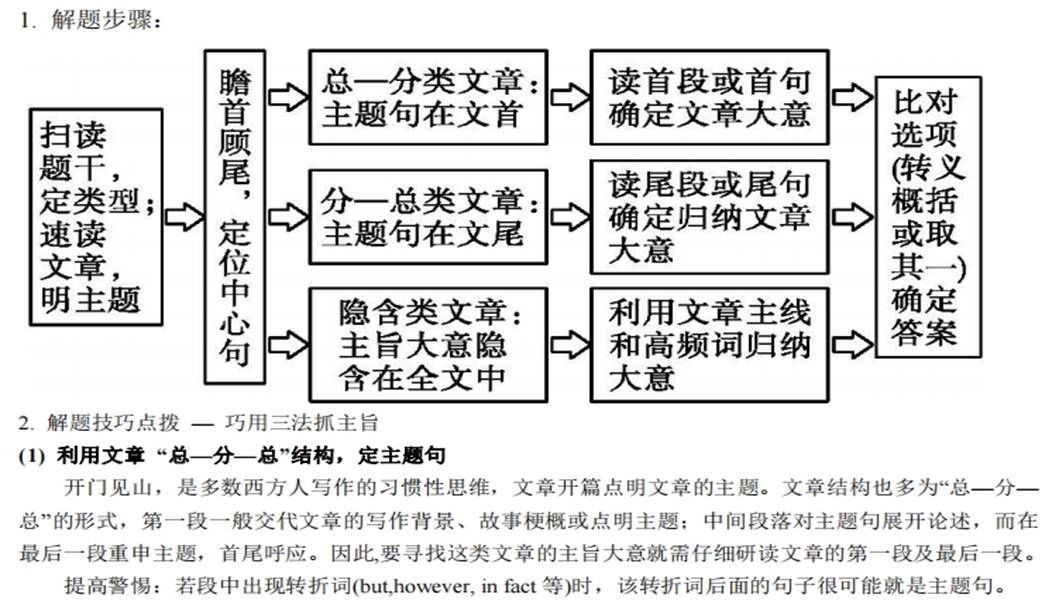

加入时间:2022-05-25

加入时间:2022-05-25

加入时间:2022-05-25

加入时间:2022-05-25

加入时间:2022-05-25
加入时间:2022-05-25

加入时间:2022-05-25

加入时间:2022-05-25

加入时间:2022-05-25

加入时间:2022-05-25

加入时间:2022-05-25

加入时间:2022-05-25

加入时间:2022-05-25

加入时间:2022-05-25

加入时间:2022-05-25

加入时间:2022-05-25
宜兴市周铁中学高三英语阅读理解微专题二轮复习③—主旨大意题
【考情分析】主旨大意题主要是测试考生对一篇文章或一段文字的深层理解程度以及在速读中准确把握文章主旨大意的能力。一般针对某一语段或某一语篇的主题标题或目的设题。凡是问文章标题(the best title)、大意(the main idea)和写作意图(the purpose, the aim)的题目都属于此类。它要求考生在理解全文的基础上能较好地运用概括、判断、归纳、推理等逻辑思维方法,对文章进行高度概括或总结,属于高层次题。
一、常考类型
(一)段落大意题
每个段落都有一个中心思想,且中心思想通常会在段落的首句或尾句体现出来,这个句子就是常说的段落主题句。没有给出明显的主题句时,要根据段落内容概括出段落大意。
设问方式:
What does the author tell us in Paragraph...?
Which of the following can best summarize Para....?
What is the...paragraph mainly about?等。
(二)文章大意题
考查考生把握全文主题和理解中心思想的能力,即考查考生的归纳概括能力。
设问方式:
What’s the main idea/point of the passage?
Which of the following best states the main idea of the passage?
Which of the following statements best expresses the main idea/theme of the passage?等。
(三)标题归纳题
概括出文章的中心思想,并对中心思想再次加以提炼,拟定出文章的标题。文章标题可以是单词、短语,也可以是句子。
设问方式:
Which of the following is the best title of the passage?
What would be the best title for the passage?等。
二、错误选项设置特点
1.以偏盖全。只是局部信息或者是一句没有展开论述的话。以个别信息或个别字眼作为选项的设置内容,或者以次要的事实或细节冒充全文的主要观点。
2.过于笼统。干扰项所归纳、概括的范围过大,超过文章实际所讨论的内容。或与细节脱节,没有对该篇阅读材料的中心细节点提及。
3.张冠李戴。命题者有意地把属于A的特征放在B的身上,构成一个干扰项。考生不注意的情况下,会造成错选答案。
4.把读者观点或者大众观点强加于作者。读者往往根据自己的常识或者普遍性思维的观点对文章进行判断而忽视了作者的见解。
5.无中生有或似是而非。有的干扰项中的关键词语好像在文章中谈到了,但认真分析之后你会发现这类干扰项的内容与文章的内容毫无联系。
三、解题技巧
(一)段落大意题




典例1
Popularity is a well-explored subject in social psychology. Mitch Prinstein, a professor of clinical psychology sorts the popular into two categories: the likable and the status seekers. The likables’ plays-well-with-others qualities strengthen schoolyard friendships, jump-start interpersonal skills and, when tapped early, are employed ever after in life and work. Then there's the kind of popularity that appears in adolescence: status born of power and even dishonorable behavior.
1. What is the second paragraph mainly about?
A. The classification of the popular.
B. The characteristics of adolescents.
C. The importance of interpersonal skills.
D. The causes of dishonorable behavior.
典例2:(2023·新高考Ⅰ卷·D篇节选)
This effect capitalizes on the fact that when people make errors, those errors aren’t always the same.Some people will tend to overestimate, and some to underestimate.When enough of these errors are averaged together, they cancel each other out, resulting in a more accurate estimate.If people are similar and tend to make the same errors, then their errors won’t cancel each other out.In more technical terms, the wisdom of crowds requires that people’s estimates be independent.If for whatever reasons, people’s errors become correlated or dependent, the accuracy of the estimate will go down.
32. What is Paragraph 2 of the text mainly about?
A. The methods of estimation.
B. The underlying logic of the effect.
C. The causes of people’s errors.
D. The design of Galton’s experiment.
(二)文章大意题

【例题1】
We may think we're a culture that gets rid of our worn technology at the first sight of something shiny and new, but a new study shows that we keep using our old devices well after they go out of style. That’s bad news for the environment — and our wallets — as these outdated devices consume much more energy than the newer ones that do the same things.
To figure out how much power these devices are using, Callie Babbitt and her colleagues at the Rochester Institute of Technology in New York tracked the environmental costs for each product throughout its life — from when its minerals are mined to when we stop using the device. This method provided a readout for how home energy use has evolved since the early 1990s. Devices were grouped by generation — Desktop computers, basic mobile phones, and box-set TVs defined 1992. Digital cameras arrived on the scene in 1997. And MP3 players, smart phones, and LCD TVs entered homes in 2002, before tablets and e-readers showed up in 2007.
As we accumulated more devices, however, we didn't throw out our old ones. "The living-room television is replaced and gets planted in the kids' room, and suddenly one day, you have a TV in every room of the house," said one researcher. The average number of electronic devices rose from four per household in 1992 to 13 in 2007. We're not just keeping these old devices — we continue to use them. According to the analysis of Babbitt’s team, old desktop monitors and box TVs with cathode ray tubes are the worst devices with their energy consumption and contribution to greenhouse gas emissions more than doubling during the 1992 to 2007 window.
So what's the solution? The team’s data only went up to 2007, but the researchers also explored what would happen if consumers replaced old products with new electronics that serve more than one function, such as a tablet for word processing and TV viewing. They found that more on-demand entertainment viewing on tablets instead of TVs and desktop computers could cut energy consumption by 44%.
主题句:_________________________________________________________________________________
(2) 利用文章时间顺序或“分述—总说”结构,定主旨句
常见的结构有按时间顺序或“分述—总说”结构。按时间先后顺序说明某一件事、某一理论的发展过程的文章,主题句通常在首段或末段;而采用“分述—总说”结构的文章,前几段分别说明,末段总结,这类文章主题常在末段。
【例题1】
Before the 1830s, most newspapers were sold through annual subscriptions in America, usually $8 to $10 a year. Today $8 or $10 seems a small amount of money, but at that time these amounts were forbidding to most citizens. Accordingly, newspapers were read almost only by rich people in politics or the trades. In addition, most newspapers had little in them that would appeal to a mass audience. They were dull and visually forbidding. But the revolution that was taking place in the 1830s would change all that.
The trend, then, was toward the "penny paper"-a term referring to papers made widely available to the public. It meant any inexpensive newspaper; perhaps more importantly it meant newspapers that could be bought in single copies on the street.
This development did not take place overnight. It had been possible(but not easy) to buy single copies of newspapers before 1830, but this usually meant the reader had to go down to the printer's office to purchase a copy. Street sales were almost unknown. However, within a few years, street sales of newspapers would be commonplace in eastern cities. At first the price of single copies was seldom a penny-usually two or three cents was charged-and some of the older well-known papers charged five or six cents. But the phrase "penny paper " caught the public's fancy, and soon there would be papers that did indeed sell for only a penny.
This new trend of newspapers for "the man on the street" did not begin well. Some of the early ventures(企 业)were immediate failures. Publishers already in business, people who were owners of successful papers, had little desire to change the tradition. It took a few youthful and daring businessmen to get the ball rolling.
This passage is mainly about __________________________________________________________________
【例题2】
Marian Bechtel sits at West Palm Beach’s Bar Louie counter by herself, quietly reading her e-book as she waits for her salad. What is she reading? None of your business! Lunch is Bechtel’s “me” time. And like more Americans, she’s not alone.
A new report found 46 percent of meals are eaten alone in America. More than half(53percent) have breakfast alone and nearly half(46percent) have lunch by themselves. Only at dinnertime are we eating together anymore,74 percent, according to statistics from the report.
“I prefer to go out and be out. Alone, but together, you know?” Bechtel said, looking up from her book. Bechtel, who works in downtown West Palm Beach, has lunch with coworkers sometimes, but like many of us, too often works through lunch at her desk. A lunchtime escape allows her to keep a boss from tapping her on the shoulder. She returns to work feeling energized. “Today, Ijust wanted some time to myself,” she said.
Just two seats over, Andrew Mazoleny, a local videographer, is finishing his lunch at the bar. He likes that he can sit and check his phone in peace or chat up the barkeeper with whom he's on a first-name basis if he wants to have a little interaction(交流). “I reflect on how my day’s gone and think about the rest of the week,” he said. “It’s a chance for self-reflection. You return to work recharged and with a plan.”
That freedom to choose is one reason more people like to eat alone. There was a time when people may have felt awkward about asking for a table for one, but those days are over. Now, we have our smartphones to keep us company at the table. “It doesn’t feel as alone as it may have before all the advances in technology,” said Laurie Demerit, whose company provided the statistics for the report.
2. What is the text mainly about?
A. The trend of having meals alone. B. The importance of self-reflection.
C. The stress from working overtime. D. The advantage of wireless technology.
(3) 文章若无主题句,抓住高频词。
文章的主题作者往往有意识地反复论述。因此,要善于抓住、利用这些反复出现的中心词, 即高频词。
【例题】
Benjamin West, the father of American painting, showed his talent for art when he was only six years of age. But he did not know about brushes before a visitor told him he needed one. In those days, a brush was made from camel’s hair. There were no camels nearby. Benjamin decided that cat hair would work instead. He cut some fur from the family cat to make a brush.
The brush did not last long. Soon Benjamin needed more fur. Before long, the cat began to look ragged(蓬 乱). His father said that the cat must be sick. Benjamin was forced to admit what he had been doing.
The cat’s lot was about to improve. That year, one of Benjamin’s cousins, Mr. Pennington, came to visit. He was impressed with Benjamin’s drawings. When he went home, he sent Benjamin a box of paint and some brushes. He also sent six engravings( 版 画) by an artist. These were the first pictures and first real paint and brushes Benjamin had ever seen. In 1747, when Benjamin was nine years old, Mr.Pennington returned for another visit. He was amazed at what Benjamin had done with his gift. He asked Benjamin’s parents if he might take the boy to Philadelphia for a visit.
In the city, Mr.Pennington gave Benjamin materials for creating oil paintings. The boy began a landscape painting. Wiliams, a well-known painter, came to see him work. Wiliams was impressed with Benjamin and gave him two classic books on painting to take home. The books were long and dull. Benjamin could read only a little, having been a poor student. But he later said, “Those two books were my companions by day, and under my pillow at night.” While it is likely that he understood very little of the books, they were his introduction to classical paintings. The nine-year-old boy decided then that he would be an artist.
1. What is the text mainly about?
A. Benjamin’s visit to Philadelphia.
B. Williams ’ influence on Benjamin.
C. The beginning of Benjamin’s life as an artist.
D. The friendship between Benjamin and Pennington.
【温馨提示】
务必牢记“永远把主旨大意题放在最后做 ”。因为需要读完全文才能把握文章主题,所以在解答此类题 目时,考生不要急于去找答案,不论它出现在什么位置都把它作为最后一道题来做。在做完另外几道题目后, 无疑会有助于考生加深对整篇文章的理解。
典例:(2023年1月·浙江高考·B篇)
Live with roommates? Have friends and family around you? Chances are that if you’re looking to live a more sustainable lifestyle, not everyone around you will be ready to jump on that bandwagon.
I experienced this when I started switching to a zero waste lifestyle five years ago, as I was living with my parents, and I continue to experience this with my husband, as he is not completely zero waste like me.I’ve learned a few things along the way though, which I hope you’ll find encouraging if you’re doing your best to figure out how you can make the change in a not-always-supportive household.
Zero waste was a radical lifestyle movement a few years back.I remember showing my parents a video of Bea Johnson, sharing how cool I thought it would be to buy groceries with jars, and have so little trash! A few days later, I came back with my first jars of zero waste groceries, and my dad commented on how silly it was for me to carry jars everywhere.It came off as a bit discouraging.
Yet as the months of reducing waste continued, I did what I could that was within my own reach.I had my own bedroom, so I worked on removing things I didn’t need.Since I had my own toiletries (洗漱用品), I was able to start personalising my routine to be more sustainable.I also offered to cook every so often, so I portioned out a bit of the cupboard for my own zero waste groceries.Perhaps your household won’t entirely make the switch, but you may have some control over your own personal spaces to make the changes you desire.
As you make your lifestyle changes, you may find yourself wanting to speak up for yourself if others comment on what you’re doing, which can turn itself into a whole household debate.If you have individuals who are not on board, your words probably won’t do much and can often leave you feeling more discouraged.
So here is my advice: Lead by action.
27.What is the text mainly about?
A.How to get on well with other family members.
B.How to have one’s own personal space at home.
C.How to live a zero waste lifestyle in a household.
D.How to control the budget when buying groceries.
(三)标题归纳题
★理解标题的3大特点
一个好的标题应具备三大特点:
1.概括性——准确而又简短;
2.针对性——标题外延正好与文章内容相符;
3.醒目性——能引发读者的阅读欲望。
★巧用3大方法确定文章标题
1.正面肯定法:在理解文章主旨的基础上,揣摩哪个选项能准确概括主旨;
2.反面否定法:撇开原文,拿各个备选项去设想用它们写出来的“文章”将是什么内容,然后和原文章对照,一一排除不符选项;
3.研读备选项本身:研读备选项里面的中心词、修饰词的变化、结构、概括性等。
典例:(2023·新高考Ⅱ卷·B篇)
Turning soil, pulling weeds, and harvesting cabbage sound like tough work for middle and high school kids.And at first it is, says Abby Jaramillo, who with another teacher started Urban Sprouts, a school garden program at four low-income schools.
The program aims to help students develop science skills, environmental awareness, and healthy lifestyles.
Jaramillo’s students live in neighborhoods where fresh food and green space are not easy to find and fast food restaurants outnumber grocery stores.“The kids literally come to school with bags of snacks and large bottles of soft drinks,”she says.“They come to us thinking vegetables are awful, dirt is awful, insects are awful.” Though some are initially scared of the insects and turned off by the dirt, most are eager to try something new.
Urban Sprouts’ classes, at two middle schools and two high schools, include hands-on experiments such as soil testing, flower-and-seed dissection, tastings of fresh or dried produce, and work in the garden.Several times a year, students cook the vegetables they grow, and they occasionally make salads for their entire schools.
Program evaluations show that kids eat more vegetables as a result of the classes.“We have students who say they went home and talked to their parents and now they’re eating differently,” Jaramillo says.
She adds that the program’s benefits go beyond nutrition.Some students get so interested in gardening that they bring home seeds to start their own vegetable gardens.Besides, working in the garden seems to have a calming effect on Jaramillo’s special education students, many of whom have emotional control issues.“They get outside,” she says, “and they feel successful.”
27.What can be a suitable title for the text?
A.Rescuing School Gardens B.Experiencing Country Life
C.Growing Vegetable Lovers D.Changing Local Landscape